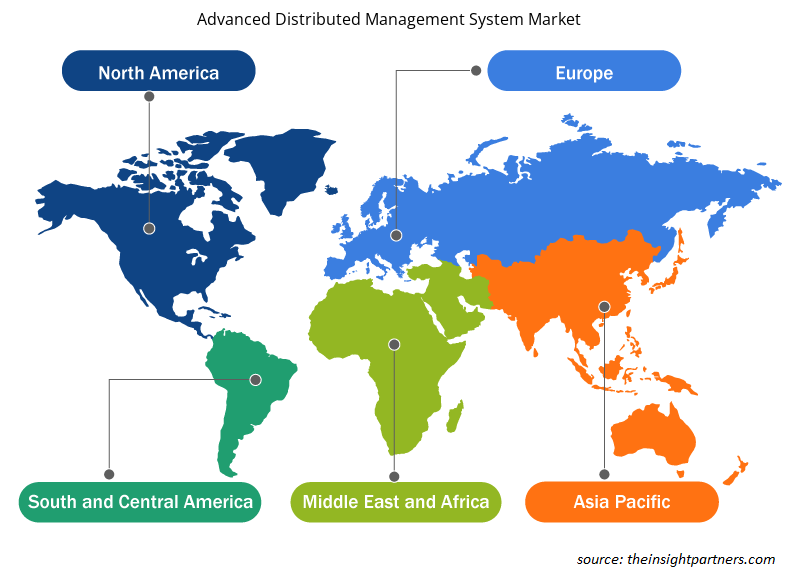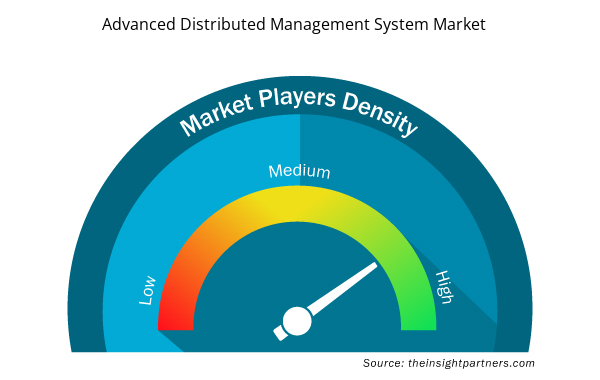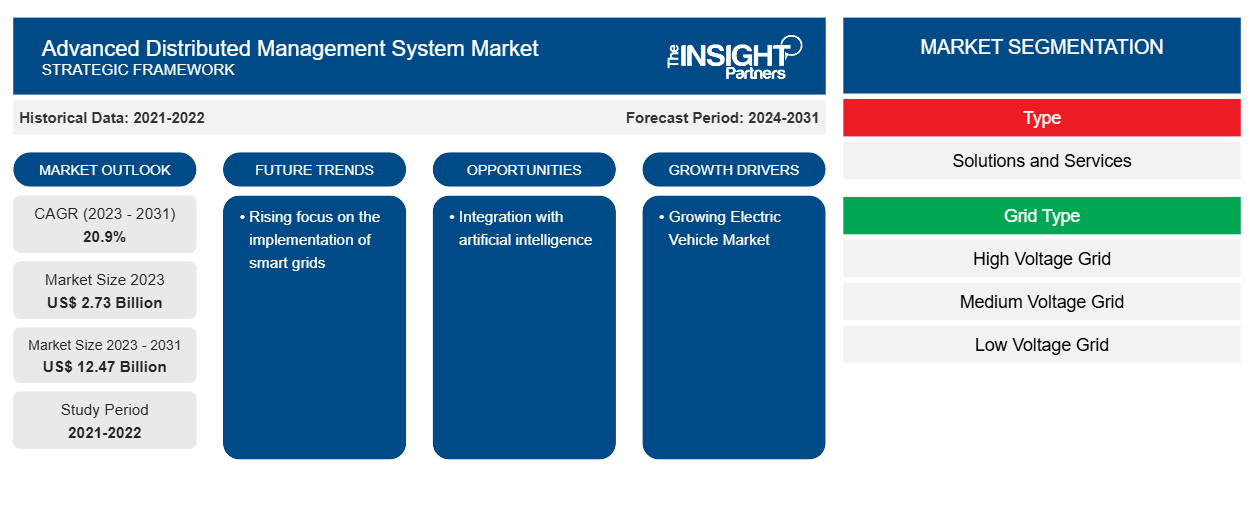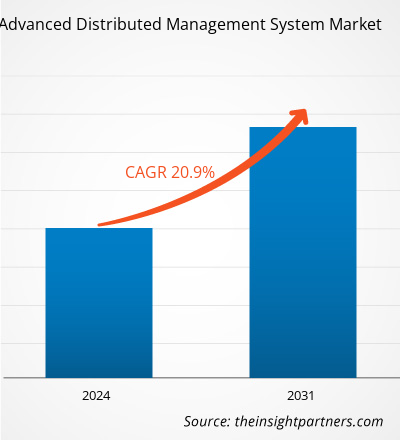Der Markt für moderne verteilte Managementsysteme soll von 2,73 Milliarden US-Dollar im Jahr 2023 auf 12,47 Milliarden US-Dollar im Jahr 2031 anwachsen. Der Markt soll zwischen 2023 und 2031 eine durchschnittliche jährliche Wachstumsrate (CAGR) von 20,9 % verzeichnen. Das schnelle Wachstum des Marktes für Elektrofahrzeuge und die staatliche Förderung intelligenter Stromnetze dürften weiterhin der Schlüssel zu den Markttrends für moderne verteilte Managementsysteme sein.
Marktanalyse für fortschrittliche verteilte Managementsysteme
Die Nachfrage nach Lösungen mit hoher Zuverlässigkeit, verbesserter Stromqualität, erneuerbaren Energiequellen und Datensicherheit steigt. Dieser Faktor trägt zur Nachfrage nach fortschrittlichen Verteilungsmanagementsystemen bei. Darüber hinaus verlangen die Kunden nach Technologien und Lösungen, die mit unterbrochenen Stromflüssen umgehen können, was zu einem weiteren Wachstum des Marktes für fortschrittliche Verteilungsmanagementsysteme führt. Die steigende Nachfrage nach Elektrofahrzeugen und die Nachfrage nach sicheren und zuverlässigen integrierten Einzelplattformen fördern das Marktwachstum weiter. Die Anforderung, die Stromkosten und Stromverluste zu minimieren, führt zur Einführung eines fortschrittlichen verteilten Managementsystems.
Marktübersicht für erweiterte verteilte Managementsysteme
Zahlreiche Versorgungsunternehmen implementieren derzeit Advanced Distribution Management Systems (ADMS), eine Softwareplattform, die mehrere Versorgungssysteme integriert und die Wiederherstellung nach Ausfällen sowie die Leistung des Verteilnetzes automatisiert. Zu den ADMS-Funktionen können auch die automatische Fehlerortung, -isolierung und -wiederherstellung (FLISR), die Reduzierung der Erhaltungsspannung, das Spitzenlastmanagement und die Optimierung der Blindleistung (Volt/VAR) gehören. Darüber hinaus wandelt ein ADMS Versorgungsunternehmen von Papierkram und manuellen Prozesssystemen in Systeme um, die Echtzeit- oder nahezu Echtzeitdaten, automatisierte Prozesse und einheitliche Systeme verwenden.
Passen Sie diesen Bericht Ihren Anforderungen an
Sie erhalten kostenlos individuelle Anpassungen an jedem Bericht, einschließlich Teilen dieses Berichts oder einer Analyse auf Länderebene, eines Excel-Datenpakets sowie tolle Angebote und Rabatte für Start-ups und Universitäten.
- Holen Sie sich die wichtigsten Markttrends aus diesem Bericht.Dieses KOSTENLOSE Beispiel umfasst eine Datenanalyse von Markttrends bis hin zu Schätzungen und Prognosen.
Treiber und Chancen auf dem Markt für fortschrittliche verteilte Managementsysteme
Wachsender Markt für Elektrofahrzeuge begünstigt den Markt
Die Verbreitung von Elektrofahrzeugen fördert die Einführung moderner verteilter Managementsysteme. Das moderne verteilte Managementsystem trägt zu einer besseren Planung für den verstärkten Einsatz sowie zur Verbindung von dezentraler Stromerzeugung und Elektrofahrzeugen bei. Diese Funktion optimiert die Kapitalausgaben für die Netzwerkverstärkung und -automatisierung sowie die Filterung und Berichterstattung für historische Analysen. Es umfasst Netzwerkmodellierungs- und -analysefunktionen für Übertragung und Unterübertragung, die als vollständig integriertes oder eigenständiges System bereitgestellt werden können.
Steigender Fokus auf die Implementierung intelligenter Netze
Angesichts des steigenden Bedarfs an effizienter Energie weltweit werden Smart Grid-Technologien auf der ganzen Welt implementiert. Ein fortschrittliches verteiltes Managementsystem hilft, den Energieverbrauch zu optimieren und erkennt Netzprobleme, um den effizienten Transport von Daten und Strom zu unterstützen. Daher sind das Wachstum beim Bau von Smart Cities und der Fokus der Regierung auf die Steigerung der Kohlenstoffeffizienz einige der Hauptfaktoren, die die Installation von Smart Grids vorantreiben und den Markt für fortschrittliche verteilte Managementsysteme weiter vorantreiben. Einige der Regierungsinitiativen, die die Implementierung von Smart Grids vorantreiben, sind das Smart Grid Investment Grant (SGIG)-Programm und das Smart Grid Demonstration Program (SGDP) der USA, die Programme Smart Energy Grids and Storage (SEGS) in Indien und die integrierten lokalen Energiesysteme Indien-EU.
Segmentierungsanalyse des Marktberichts für erweiterte verteilte Managementsysteme
Wichtige Segmente, die zur Ableitung der Marktanalyse für fortschrittliche verteilte Managementsysteme beigetragen haben, sind Typ, Rastertyp und Vertikale.
- Nach Typ ist der Markt in Lösungen und Dienstleistungen segmentiert. Das Lösungssegment hatte im Jahr 2023 den größten Marktanteil.
- Basierend auf dem Netztyp ist der Markt in Hochspannungsnetze, Mittelspannungsnetze und Niederspannungsnetze segmentiert. Das Segment der Hochspannungsnetze dürfte mit der höchsten durchschnittlichen jährlichen Wachstumsrate wachsen.
- Nach Branchen ist der Markt in Industrie und Gewerbe unterteilt. Das Industriesegment dürfte die höchste jährliche Wachstumsrate aufweisen.
Marktanteilsanalyse für erweiterte verteilte Managementsysteme nach Geografie
Der geografische Umfang des Marktberichts zu fortschrittlichen verteilten Managementsystemen ist hauptsächlich in fünf Regionen unterteilt: Nordamerika, Asien-Pazifik, Europa, Naher Osten und Afrika sowie Südamerika/Süd- und Mittelamerika.
Die Region Asien-Pazifik wird voraussichtlich die höchste jährliche Wachstumsrate aufweisen. Die Verbreitung von Smart Grid-Initiativen durch die Regierung führt zur Installation von Smart Grids. Der wachsende Markt für Elektrofahrzeuge in der Region treibt die Nachfrage nach Lösungen an, die bei der fortschrittlichen Planung und Analyse des Energiemanagements helfen und den Einsatz fortschrittlicher verteilter Managementsystemtechnologie vorantreiben.
Regionale Einblicke in den Markt für erweiterte verteilte Managementsysteme
Die regionalen Trends und Faktoren, die den Markt für fortschrittliche verteilte Managementsysteme während des gesamten Prognosezeitraums beeinflussen, wurden von den Analysten von Insight Partners ausführlich erläutert. In diesem Abschnitt werden auch die Marktsegmente und die Geografie fortschrittlicher verteilter Managementsysteme in Nordamerika, Europa, im asiatisch-pazifischen Raum, im Nahen Osten und Afrika sowie in Süd- und Mittelamerika erörtert.

- Erhalten Sie regionale Daten zum Markt für fortschrittliche verteilte Managementsysteme
Umfang des Marktberichts zu erweiterten verteilten Managementsystemen
| Berichtsattribut | Details |
|---|---|
| Marktgröße im Jahr 2023 | 2,73 Milliarden US-Dollar |
| Marktgröße bis 2031 | 12,47 Milliarden US-Dollar |
| Globale CAGR (2023 - 2031) | 20,9 % |
| Historische Daten | 2021-2022 |
| Prognosezeitraum | 2024–2031 |
| Abgedeckte Segmente | Nach Typ
|
| Abgedeckte Regionen und Länder | Nordamerika
|
| Marktführer und wichtige Unternehmensprofile |
|
Dichte der Marktteilnehmer für erweiterte verteilte Managementsysteme: Die Auswirkungen auf die Geschäftsdynamik verstehen
Der Markt für fortschrittliche verteilte Managementsysteme wächst rasant. Dies wird durch die steigende Nachfrage der Endnutzer aufgrund von Faktoren wie sich entwickelnden Verbraucherpräferenzen, technologischen Fortschritten und einem größeren Bewusstsein für die Vorteile des Produkts vorangetrieben. Mit der steigenden Nachfrage erweitern Unternehmen ihr Angebot, entwickeln Innovationen, um die Bedürfnisse der Verbraucher zu erfüllen, und nutzen neue Trends, was das Marktwachstum weiter ankurbelt.
Die Marktteilnehmerdichte bezieht sich auf die Verteilung der Firmen oder Unternehmen, die in einem bestimmten Markt oder einer bestimmten Branche tätig sind. Sie gibt an, wie viele Wettbewerber (Marktteilnehmer) in einem bestimmten Marktraum im Verhältnis zu seiner Größe oder seinem gesamten Marktwert präsent sind.
Die wichtigsten Unternehmen, die auf dem Markt für fortschrittliche verteilte Managementsysteme tätig sind, sind:
- AutoGrid Systems, Inc.
- GE DIGITAL
- Hitachi Energy Ltd.
- Indra
- Orakel
- Betriebstechnologie, Inc.
Haftungsausschluss : Die oben aufgeführten Unternehmen sind nicht in einer bestimmten Reihenfolge aufgeführt.

- Erhalten Sie einen Überblick über die wichtigsten Akteure auf dem Markt für erweiterte verteilte Managementsysteme
Nachrichten und aktuelle Entwicklungen zum Markt für erweiterte verteilte Managementsysteme
Der Markt für fortschrittliche verteilte Managementsysteme wird durch die Erfassung qualitativer und quantitativer Daten nach Primär- und Sekundärforschung bewertet, die wichtige Unternehmensveröffentlichungen, Verbandsdaten und Datenbanken umfasst. Im Folgenden finden Sie eine Liste der Entwicklungen auf dem Markt:
- Im April 2022 setzte der National Grid Electricity System Operator (ESO) die Lösung Effective Inertia Metering & Forecasting von GE Digital im gesamten britischen Stromnetz ein, um die Einspeisung erneuerbarer Energiequellen in das Netz zu unterstützen. Die Lösung von GE Digital wurde entwickelt, um wertvolle Funktionen bereitzustellen, die das Management und die Ingenieure von National Grid ESO täglich über die Trägheit des Netzes informieren und dazu beitragen, dass das System einen Generatorausfall im schlimmsten Fall bewältigen kann. (Quelle: GE Digital, Pressemitteilung, 2022)
- Im Februar 2024 gab Aspen Technology, Inc. (NASDAQ: AZPN), ein weltweit führender Anbieter von Industriesoftware, die Implementierung seiner digitalen Netzmanagementlösungen durch Adani Electricity, ein führendes Energieunternehmen in Indien, bekannt. Das SCADA-System der nächsten Generation von AspenTech und sein Advanced Distribution Management System (ADMS) wurden in das neue Netzwerkbetriebszentrum von Adani Electricity in Hiranandani Powai integriert, um ein intelligentes Stromnetz in Echtzeit zu überwachen und zu steuern, das seinen mehr als drei Millionen Kunden in ganz Mumbai einen zuverlässigen, sicheren und zuverlässigen Service bietet. Mit dieser Implementierung positioniert sich Adani Electricity als führender Anbieter unter den fortschrittlichsten Versorgungsunternehmen in der Region. (Quelle: Aspen Technology, Inc., Pressemitteilung, 2024)
Marktbericht zu fortschrittlichen verteilten Managementsystemen – Abdeckung und Ergebnisse
Der Bericht „Marktgröße und Prognose für erweiterte verteilte Managementsysteme (2021–2031)“ bietet eine detaillierte Analyse des Marktes, die die folgenden Bereiche abdeckt:
- Marktgröße und Prognose auf globaler, regionaler und Länderebene für alle wichtigen Marktsegmente, die im Rahmen des Projekts abgedeckt sind
- Marktdynamik wie Treiber, Beschränkungen und wichtige Chancen
- Wichtige Zukunftstrends
- Detaillierte PEST/Porters Five Forces- und SWOT-Analyse
- Globale und regionale Marktanalyse mit wichtigen Markttrends, wichtigen Akteuren, Vorschriften und aktuellen Marktentwicklungen
- Branchenlandschaft und Wettbewerbsanalyse, einschließlich Marktkonzentration, Heatmap-Analyse, prominenten Akteuren und aktuellen Entwicklungen
- Detaillierte Firmenprofile
- Historische Analyse (2 Jahre), Basisjahr, Prognose (7 Jahre) mit CAGR
- PEST- und SWOT-Analyse
- Marktgröße Wert/Volumen – Global, Regional, Land
- Branche und Wettbewerbsumfeld
- Excel-Datensatz



Report Coverage
Revenue forecast, Company Analysis, Industry landscape, Growth factors, and Trends

Segment Covered
This text is related
to segments covered.

Regional Scope
North America, Europe, Asia Pacific, Middle East & Africa, South & Central America

Country Scope
This text is related
to country scope.
Häufig gestellte Fragen
The global advanced distributed management system market was estimated to be US$ 2.73 billion in 2023 and is expected to grow at a CAGR of 20.9% during the forecast period 2023 - 2031.
The rapid growth in the electric vehicle market and the government's towards the implementation of smart grids are the major factors that propel the global advanced distributed management system market.
Integration with artificial intelligence is anticipated to play a significant role in the global advanced distributed management system market in the coming years.
The key players holding majority shares in the global advanced distributed management system market are GE DIGITAL; Hitachi Energy Ltd.; Operation Technology, Inc.; Schneider Electric; and Siemens.
The global advanced distributed management system market is expected to reach US$ 12.47 billion by 2031.
The incremental growth expected to be recorded for the global advanced distributed management system market during the forecast period is US$ 9.73 billion.
Trends and growth analysis reports related to Technology, Media and Telecommunications : READ MORE..
The Insight Partners performs research in 4 major stages: Data Collection & Secondary Research, Primary Research, Data Analysis and Data Triangulation & Final Review.
- Data Collection and Secondary Research:
As a market research and consulting firm operating from a decade, we have published and advised several client across the globe. First step for any study will start with an assessment of currently available data and insights from existing reports. Further, historical and current market information is collected from Investor Presentations, Annual Reports, SEC Filings, etc., and other information related to company’s performance and market positioning are gathered from Paid Databases (Factiva, Hoovers, and Reuters) and various other publications available in public domain.
Several associations trade associates, technical forums, institutes, societies and organization are accessed to gain technical as well as market related insights through their publications such as research papers, blogs and press releases related to the studies are referred to get cues about the market. Further, white papers, journals, magazines, and other news articles published in last 3 years are scrutinized and analyzed to understand the current market trends.
- Primary Research:
The primarily interview analysis comprise of data obtained from industry participants interview and answers to survey questions gathered by in-house primary team.
For primary research, interviews are conducted with industry experts/CEOs/Marketing Managers/VPs/Subject Matter Experts from both demand and supply side to get a 360-degree view of the market. The primary team conducts several interviews based on the complexity of the markets to understand the various market trends and dynamics which makes research more credible and precise.
A typical research interview fulfils the following functions:
- Provides first-hand information on the market size, market trends, growth trends, competitive landscape, and outlook
- Validates and strengthens in-house secondary research findings
- Develops the analysis team’s expertise and market understanding
Primary research involves email interactions and telephone interviews for each market, category, segment, and sub-segment across geographies. The participants who typically take part in such a process include, but are not limited to:
- Industry participants: VPs, business development managers, market intelligence managers and national sales managers
- Outside experts: Valuation experts, research analysts and key opinion leaders specializing in the electronics and semiconductor industry.
Below is the breakup of our primary respondents by company, designation, and region:

Once we receive the confirmation from primary research sources or primary respondents, we finalize the base year market estimation and forecast the data as per the macroeconomic and microeconomic factors assessed during data collection.
- Data Analysis:
Once data is validated through both secondary as well as primary respondents, we finalize the market estimations by hypothesis formulation and factor analysis at regional and country level.
- Macro-Economic Factor Analysis:
We analyse macroeconomic indicators such the gross domestic product (GDP), increase in the demand for goods and services across industries, technological advancement, regional economic growth, governmental policies, the influence of COVID-19, PEST analysis, and other aspects. This analysis aids in setting benchmarks for various nations/regions and approximating market splits. Additionally, the general trend of the aforementioned components aid in determining the market's development possibilities.
- Country Level Data:
Various factors that are especially aligned to the country are taken into account to determine the market size for a certain area and country, including the presence of vendors, such as headquarters and offices, the country's GDP, demand patterns, and industry growth. To comprehend the market dynamics for the nation, a number of growth variables, inhibitors, application areas, and current market trends are researched. The aforementioned elements aid in determining the country's overall market's growth potential.
- Company Profile:
The “Table of Contents” is formulated by listing and analyzing more than 25 - 30 companies operating in the market ecosystem across geographies. However, we profile only 10 companies as a standard practice in our syndicate reports. These 10 companies comprise leading, emerging, and regional players. Nonetheless, our analysis is not restricted to the 10 listed companies, we also analyze other companies present in the market to develop a holistic view and understand the prevailing trends. The “Company Profiles” section in the report covers key facts, business description, products & services, financial information, SWOT analysis, and key developments. The financial information presented is extracted from the annual reports and official documents of the publicly listed companies. Upon collecting the information for the sections of respective companies, we verify them via various primary sources and then compile the data in respective company profiles. The company level information helps us in deriving the base number as well as in forecasting the market size.
- Developing Base Number:
Aggregation of sales statistics (2020-2022) and macro-economic factor, and other secondary and primary research insights are utilized to arrive at base number and related market shares for 2022. The data gaps are identified in this step and relevant market data is analyzed, collected from paid primary interviews or databases. On finalizing the base year market size, forecasts are developed on the basis of macro-economic, industry and market growth factors and company level analysis.
- Data Triangulation and Final Review:
The market findings and base year market size calculations are validated from supply as well as demand side. Demand side validations are based on macro-economic factor analysis and benchmarks for respective regions and countries. In case of supply side validations, revenues of major companies are estimated (in case not available) based on industry benchmark, approximate number of employees, product portfolio, and primary interviews revenues are gathered. Further revenue from target product/service segment is assessed to avoid overshooting of market statistics. In case of heavy deviations between supply and demand side values, all thes steps are repeated to achieve synchronization.
We follow an iterative model, wherein we share our research findings with Subject Matter Experts (SME’s) and Key Opinion Leaders (KOLs) until consensus view of the market is not formulated – this model negates any drastic deviation in the opinions of experts. Only validated and universally acceptable research findings are quoted in our reports.
We have important check points that we use to validate our research findings – which we call – data triangulation, where we validate the information, we generate from secondary sources with primary interviews and then we re-validate with our internal data bases and Subject matter experts. This comprehensive model enables us to deliver high quality, reliable data in shortest possible time.


 Holen Sie sich ein kostenloses Muster für diesen Bericht
Holen Sie sich ein kostenloses Muster für diesen Bericht